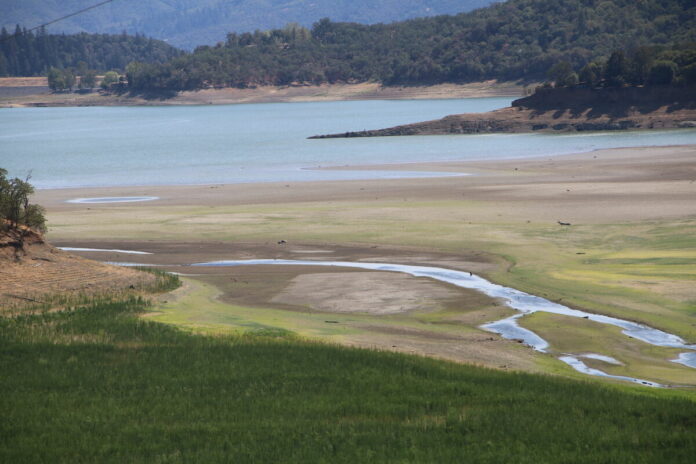Cloverdale’s water restrictions are tightening to a 35% mandatory reduction in water use. The Cloverdale City Council unanimously voted on Aug. 11 to declare a Stage 4 water shortage emergency, and to increase its water reduction goal for the city from 25% to 35%. The decision comes a little over a week after the State Water Control Board issued curtailments for senior water rights holders in the upper Russian River, which includes Cloverdale.
The 35% reduction is calculated when compared to water use from the same month in 2020. For example, water use in August 2021 will be compared to water use from August 2020.
Heading into the meeting, the council was asked by city staff to increase Cloverdale’s mandatory water reduction goal from 25% to 40% and to assign the city at either a Stage 4 or Stage 5 water emergency. A Stage 4 emergency limits irrigation to one day a week, establishes rations for all water use categories and increases the city’s water shortage surcharge. A Stage 5 emergency prohibits irrigation, decreases the ration for all water use categories and increases the city’s water shortage surcharge.
According to City Manager David Kelley, the city started to see the trend for August 2021 water usage start to dip below the 25% reduction target, organically getting closer to the 40% reduction that was originally proposed for the council to approve during its Aug. 11 meeting.
However, he noted that, even with a 40% reduction in water use, the city wouldn’t be near the 55 gallons per capita per day (gpcd) that’s required by the State Water Control Board’s curtailment order.
“It’s a very significant decrease from where we are today and would require a very significant savings of water to meet that target,” Kelley said. Later, Kelley said the city is currently trending at about 88 gpcd and, with the 40% reduction, the city could hit around 70 gpcd.
During council deliberations about what level of water restriction to impose on water users, council members were hesitant to approve the more stringent reduction measures presented to them — declaring a Stage 5 emergency and implementing a 40% reduction — and expressed a desire to ease residents into those restrictions, should they be necessary.
“During the last drought, the citizens of Cloverdale lowered their per capita water use more than any other city in Sonoma County,” said Councilmember Melanie Bagby, using it as an example of how the community pulls through in times of need.
But that same level of water reduction performed during the last drought is what gave public commenter Jeanne Cox pause — her house still abides by some of the same water use reduction practices that it implemented years ago. For her and other similar households, she wondered what else they could cut in order to save even more water.
“We started good habits during the last drought and we’ve continued those. When there was no rain the last few years, we cut down even further on loads of laundry or using the dishwasher,” she said, also asking for clarification about whether or not the city would prioritize a percentage cut or a gpcd goal. ”If it’s going to be a percentage reduction, how far back are we going to look? If we have to cut another 55% of what we’re doing now, we might as well move out.”
Council members echoed that they had heard similar inquiries from residents concerned about how stricter use targets might be hit.
“I realize that a lot of people have stepped up and have done the right thing … people have really cut back over the years and this is an additional cut, which makes it very hard and difficult. We talk about public health and safety and that means people need to be able to wash their hands, they need to be able to take a shower, they need to be able to wash their clothes,” Councilmember Joe Palla said.
“I want to make sure we try to reduce the impact as much as possible for families, recognizing that they’re going to do as much as possible to reduce their use during the drought,” he continued.
In addition to the 35% reduction in water use, a Stage 4 emergency limits irrigation to one day a week, establishes rations for all water use categories and increases the city’s water shortage surcharge.
The council agreed that it wanted to keep the door open for future restrictions on water use, but that it would move forward with implementing the less severe of the options presented to them.
What regulations are being handed down to the city?
The catalyst for the city’s reevaluation of water use is a curtailment order for upper Russian River water use coming down from the State Water Control Board due to decreasing water levels at Lake Mendocino. The curtailment order in part requires the City of Cloverdale, along with other jurisdictions pulling from the upper Russian River, to cut use to 55 gpcd. A curtailment order for the lower Russian River, which doesn’t impact Cloverdale, was issued this week.
If the city can’t comply with the water board’s requirements, the state board can issue fines to the city.
“This has potentially significant impacts on the utility’s finances,” Kelley said, noting that along with the fines, a reduction in water use also leads to a reduction in revenue used to pay for the city’s water system upkeep and capital improvements.
But the city’s legal consultant, a team at Meyers Nave, said it has various options to try and lessen the impact that the curtailment order might have on the city and its residents.
“What we’re facing at this point is that the state board has issued orders to all water right holders — whether they’re senior or junior water right holders. The order is essentially a cease and desist (for) diversions and it’s linked to calculations of the water levels of Lake Mendocino,” said Viviana Heger, of Meyers Nave.
“We don’t know that the city can hit that target (55 gpcd) … you’re trending very, very well to meet that 25% conservation goal, but you’re not trending to meet that 55 gallons per day,” Heger said.
She said that given that the city might not be able to hit the 55-gallon requirements, it has three additional options.
Chief among those, Meyers Nave is currently preparing a petition to request that the city be allowed to exceed the 55 gallons per person per day mandate. The petition will emphasize that the city is showing a good faith effort to decrease its water use and will emphasize how vital it is that the city be allowed to use more than the 55 gpcd allotment. However, city attorney Jose Sanchez said that they aren’t sure what use allowance the city will be requesting in its place.
The city can also file a more robust petition by Sept. 1 that allows it to make more legal arguments that would call into question the state water board’s ability to control the city’s senior water right. According to Heger, the state water board traditionally hasn’t been able to control pre-1914 water rights but that the water board is using a newer law that came out of the last drought that has yet to be fully interpreted.
Lastly, the city can look into how much of its water use is non-consumptive, meaning how much water returns back into the system. Filing such a petition would require the city to calculate what its non-consumptive use levels are, said Palmer Hilton of Meyers Nave, and would make the argument that the city, in reality, consumes less water than it appears.
One question that they’re still trying to find an answer to is how the curtailment orders handle commercial and industrial water use. Sanchez noted that understanding how and if that factors into the 55 gpcd requirement is integral in determining how close the city might be to hitting that goal.
Sanchez that Healdsburg also filed a petition with the board, noting that they too will be unable to meet the 55 gallon per person requirement.
“We don’t want to get into a situation where penalties are starting to be assessed. We want to be sure that we’re making every good effort that we can,” to show the board that the city is making an effort to reduce water use, Sanchez said.









